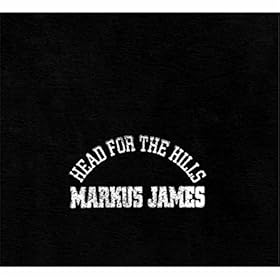|
Markus James, Head for the Hills (Firenze, 2014) Head for the Hills is certainly the most unusual album of blues and related music I've heard in a while. So much of what passes for blues these days is just so much electrified bombast, closer to the sound of guitar rock than to the spirit of the blues. Mostly, real blues survives among revivalists who seek to put their own stamps on resurrected early (rural) and mid-20th century (Chicago/Memphis/West Coast) styles. There's still worthwhile music out there, but the reigning impression is of a genre in its dotage.
On his new album -- five previous ones, unheard by me unfortunately, feature Mali musicians -- James plays assorted instruments from the past that links West Africa and the American South. Those instruments comprise gourd banjo, three-string cigar box, one-string diddley bow and beatbox alongside acoustic guitar, slide electric and dulcimer. The strong percussion behind these instruments and James's vocals (somewhere between whisper and rasp) comes from deeply rooted North Mississippi drummers, among them Kinney Kimbrough (son of the late Junior Kimbrough), Aubrey "Bill" Turner (Otha Turner), Calvin Jackson (who played with R.L. Burnside and the elder Kimbrough) and Marlon Green (the late John Lee Hooker, now James's touring partner). Over its nearly hour's length Head for the Hills engages a range of blues-based musics, acoustic and electric, and doesn't entirely neglect what one might hear (or have heard) on the Delta, as in the arresting acoustic instrumental "For Blind Willie" -- Johnson, I take it. All but the venerable folk-blues "Goin' Down South" are James originals, drenched in one way or another in the tradition. The approaches range from hard driving and thunderingly percussive to moody and melody-driven. There are 16 cuts and 15 tunes; "Head for the Hills," evoking the poverty and crime that afflict life in North Mississippi, appears twice in different arrangements. The performances were cut outside studios, on front porches, in barns, in a carport; sometimes you can hear the crickets. James fashions a music of startling power, through an artistic vision in which a personal music, grounded in a specific cultural experience, conjures up a kind of authenticity stitched together from shards of tradition. In a way the effect is illusory, since the master here is as much James himself as the rural Southern folk from which he draws. Still, equal parts creative conception and demanding technique, it's amazing, dizzying stuff, a nearly overwhelming immersion in the miraculously living soul of the blues. 

|
 Rambles.NET music review by Jerome Clark 24 January 2015 Agree? Disagree? Send us your opinions!  



 |

